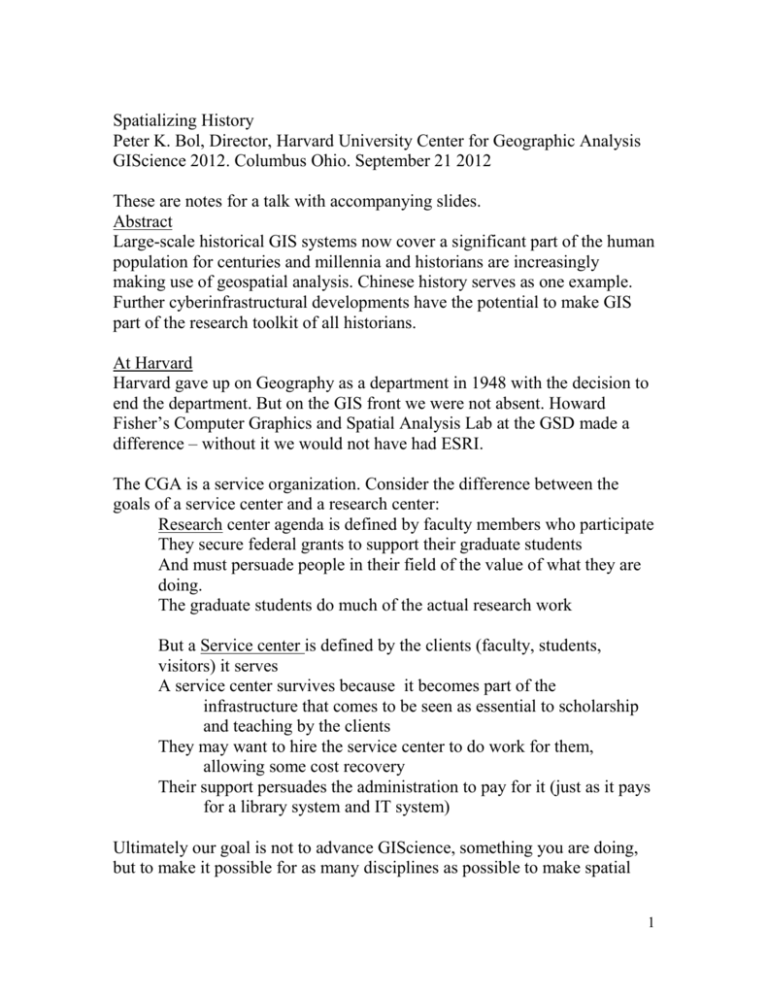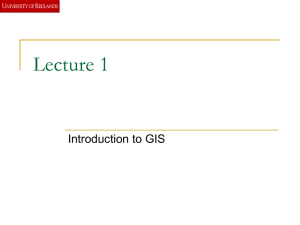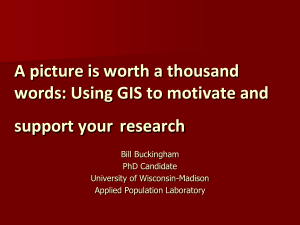bol_giscience2012_-spatializing_history_notes
advertisement

Spatializing History Peter K. Bol, Director, Harvard University Center for Geographic Analysis GIScience 2012. Columbus Ohio. September 21 2012 These are notes for a talk with accompanying slides. Abstract Large-scale historical GIS systems now cover a significant part of the human population for centuries and millennia and historians are increasingly making use of geospatial analysis. Chinese history serves as one example. Further cyberinfrastructural developments have the potential to make GIS part of the research toolkit of all historians. At Harvard Harvard gave up on Geography as a department in 1948 with the decision to end the department. But on the GIS front we were not absent. Howard Fisher’s Computer Graphics and Spatial Analysis Lab at the GSD made a difference – without it we would not have had ESRI. The CGA is a service organization. Consider the difference between the goals of a service center and a research center: Research center agenda is defined by faculty members who participate They secure federal grants to support their graduate students And must persuade people in their field of the value of what they are doing. The graduate students do much of the actual research work But a Service center is defined by the clients (faculty, students, visitors) it serves A service center survives because it becomes part of the infrastructure that comes to be seen as essential to scholarship and teaching by the clients They may want to hire the service center to do work for them, allowing some cost recovery Their support persuades the administration to pay for it (just as it pays for a library system and IT system) Ultimately our goal is not to advance GIScience, something you are doing, but to make it possible for as many disciplines as possible to make spatial 1 analysis part of how they think about their own fields, and to learn from what you are doing. We are interested in the applications The CGA has grown from 2 to 10 staff over six years, with a significant part paid for by researchers who want more extensive help. That is a sign that this is making a difference. Putting together slides of projects. I have been struck by three developments 1. Our users want to see the results on the web. 2. They want to interactivity, viewers should be users and analysts 3. They want to see change over time The spatial turn in history I am an historian, and historians it is true keep “turning”. Quantitative, Social, Cultural, Linguistic, and now Spatial. Specifically GIS Anne Knowles has shown the way with two conference volumes on GIS and history. Why GIS rather than Geography per se? Geography is more than GIS Alan Baker’s Geography and History: Bridging the Divide The AAG’s outreach to the Humanities and the idea of geohumanities Meaning of place, the social construction of place, relation between space and place History and Geography, time and space. But if we ask at what it is about geography that hold special interest, it is the power to see variation through space at different scales, to see the significance of location and distance in time and space. The chronology is a basic tool for thinking about change over time The map is the a basic tool for thinking about variation through space 2 Historians don’t only want maps, they want to be able to analyze what can be mapped – and for doing this we need GIS The great modern advancement of knowledge has been credited to three things: academic specialization, paradigm shifts, and the emergence of new tools. For the moment I am going to stand with the “tool” camp, and suppose that tools that allow us to deal with vast quantities of information (something for historians) and to see many places at once (for geographers) affects both specialization and paradigm shifts. GIS as a tool, like the telescope and the microscope, allows us to see what we could not see before. Parallels between history and geography The promise of the marriage Seeing history unfold across space, helps us account for historical change The historical record filled with spatial attributes of people, offices, events We want to be able to model space and time in the past GIS and China How I ended up here Building CHGIS 221BC -1911 Examples of the sorts of things we can do My own work makes use of spatialized data, using GIS platforms, as part of the study of China’s intellectual and cultural history. Interested in where intellectuals are from and where their associates are, among other things. In doing this I am drawing on CBDB These are the sorts of issues I want to pursue Obviously my interests are very narrow And that is the point! If we ask how to spatialize history We can’t think only in terms of using GIS for my project and my interests 3 We need to think about what we need we must make it serve as many interests as possible Religion, economy, climate studies, political, etc. Spatializing Historical studies So I turn now to my final topic: What needs to be done to ensure that the study of change overtime can also be a study of variation through space over time. What do historians need? For one thing they need some very basic education, What is the difference between a printed map (which they are all used to but which is hard to use) And a vector map which disaggregates layers And a DEM But today my topic is not education but the infrastructure that we need to build to support and facilitate research that uses data with spatial attributes. GIS is about geographic space, but in the historical record “place” not “space” was the focus. Populations are clustered in places, people come from places, postal stations are places in themselves. Places are nodes in networks, but our knowledge of the precise routes between nodes is less reliable the further back we go than our knowledge of where the nodes/places were. And reliable sources for boundaries before 1800 are few. Fundamental to the spatial analysis of data Most basic: where is the place the data is about? The fundamental GIS is a GAZETTEER GeoNames consists of 7.5 million unique features whereof 2.8 million populated places and 5.5 million alternate names. Accepts volunteered data; Can download dataset 4 National Geospatial-Intelligence Agency The GEOnet Names Server (GNS) provides access to the National Geospatial-Intelligence Agency's (NGA) and the U.S. Board on Geographic Names' (BGN) database of foreign geographic feature names. The database is the official repository of foreign place-name decisions approved by the BGN. Geographic Area of Coverage: Worldwide excluding the United States and Antarctica. For names in the U.S. and Antarctica, please visit the United States Geological Survey (USGS) Geographic Names Information System (GNIS) web site. There are no licensing requirements or restrictions in place for the use of the GNS data. But there is a second question of great concern to historians: When are these places valid When did they come into existence, belong to, move, renamed NOT in these Gazetteers Thus we need a World Historical Gazetteer (or a temporally-enabled gazetteer) Thus a first-order cyber infrastructural need in integrating history and geography, time and space, is a temporally-enabled gazetteer—in short we need a world historical gazetteer. A world-historical gazetteer is fundamental to research. As Humphrey Southall has written: “Understanding the larger socio-economic challenges facing our society requires a longterm global perspective, but in practice such perspectives are almost impossible to achieve because the necessary datasets are fragmentary or non-existent. All too often, historical research is based on a single country or a small group of advanced economies; or on just the last thirty or forty years. We need to assemble not just historical statistics but closely integrated metadata, including locations and reporting unit boundaries, so that researchers can explore alternative approaches to achieving consistency over space and time without requiring an army of assistants for each new 5 project…existing social science data repositories are insufficiently integrated…an open collaborative approach is essential…Geographical Information Science technologies are necessary…and concepts from other areas of Information Science are also needed, notably including ontologies and linked data.” (Southall, Manning et al. 2011) But what a world-historical gazetteer should contain and how it should be organized is not settled. We have pieces of it: GBHGIS (rom 1800) NHGIS (back to 1790) BUT both CGHGIS began from the need to spatialize census data, and thought in terms of polygons CHGIS (221 BCE) Idea behind CHGIS was to locate the placenames and define their relationship to each other for 2000 years of imperial history (as well as providing gazetteer services) – so your social economic, religious, political, demographic data could be mapped. AAG Clearinghouse The cyberinfrastructural challenge are obvious: to create either a unified or a federated temporally-enabled multilingual gazetteer system informed by multiple ontologies in different languages that can be sustained over time. What should a good gazetteer contain A gazetteer is about NAMES in the first instance Preceded by Belongs to Alt names Subordinate units Begin/end years -- reasons contemporary gazetteer systems have failed to make time an attribute of place. Why this should matter to archivists and future historians 6 This leads directly to a second challenge: populating a world historical gazetteer systematically on a large scale. At first glance the problem is so large that it is hard to say where to begin. There are, I think, two somewhat different starting points: Geotagging digital texts Map OCR of georeferenced maps identification of place names appearing in dated texts provides a source authority for a “before” date for a place name. The proprietary Metacarta Geographic Search and Referencing Platform from QBase appears to be the most sophisticated geo-referencing software, which presumably could be used for the geo-tagging of historical texts and, with greater degrees of uncertainty as distance from the present increases, their geo-referencing. Nevertheless, identifying all the place names in past writings provides a large amount of raw data the locations of which can be refined through iterative procedures. Manual data extraction will always be limited to specific projects; a systematic approach requires the extension of optical character recognition technology to maps. This has largely eluded software engineers but real progress is being made (Chiang and Knoblock). Since the use of theodolites in 1790s Britain, mathematically accurate maps have accumulated and now cover the entire globe. These maps provide information routes, boundaries, physical features, and locations that texts cannot provide. For a limited historical period – but one which saw global modern growth at a pace unparalleled in human history—geo-referenced maps allow us to link place names, locations, and time and thus provide a foundation for geo-referencing place names that appear in earlier texts. Manual data extraction will always be limited to specific projects; a systematic approach requires the extension of optical character recognition technology to maps. This has largely eluded software engineers but real progress is being made (Chiang and Knoblock). Given software to extract vector and text data from map scans, a third infrastructural challenge follows: creating a system for discovering and accessing geo-referenced map scans. The premier online collection of scanned maps, with over 29,000 out of a total collection of over 150,000 maps, is the Rumsey Historical Map collection (Rumsey 1996-). Of the 7 scanned maps some 22,000 have rough geo-referencing of which 1000 have been georectified using 20-50 control points per map. Some universities have larger map collections (Harvard has over 500,000 items) but none can rival Rumsey for digitized maps and geo-referenced maps. University map collections do not necessarily register their entire holdings in electronic catalogs, making a union catalog impossible. Given the costs of scanning and geo-referencing the maps in public and private collections, there is a need for a federated system for registering of maps that have been scanned or geo-referenced. OLD MAPS ONLINE Note for recent times ESRIs Change Matters website A geospatial catalog need not distinguish between raster and vector data. Here there is good news to report. Harvard, MIT, and Tufts have joined in OpenGeoportal.org, to create a portal for searching and previewing collections that can be installed on local servers (it has already been adopted by fifteen other universities or government organizations). This sets the grounds for system interoperability between the portals of different collections and thus for the ability to search across catalogs. A concomitant of this is a system for archiving and searching historical datasets, some of which could be joined to GIS boundary and point files. The Center for Historical Information and Analysis, directed by Patrick Manning at the University of Pittsburg, has launched the World-Historical Dataverse with the aim of creating such a system and founded the electronic Journal of World-Historical Information (2011-). The World-Historical Dataverse Project (WHD), housed in the World History Center, is an affiliate of the Center for Historical Information and Analysis (CHIA), and serves as the administrative center for CHIA. The WHD is governed by Director Patrick Manning and an Advisory Board. The final piece of cyberinfrastructure is an online platform for sharing and visualizing and doing preliminary analysis of spatialized historical data. Here too there has been significant progress. Google Earth has created a foundation of public understanding and an inspiration for further developments aimed at research and teaching. Social Explorer (http://www.socialexplorer.com), led by Andrew Beveridge, is a proprietary platform with free and subscription editions for the visualization of spatialized data. It includes a wide variety of historical and modern data 8 from the U.S. Census, the American Community Survey, and data on religion that allows users to create reports and download data in convenient formats quickly and easily. It allows the user to create a time series of map visualizations. ESRI’s proprietary freeware, ArcGIS Online (http://explorer.arcgis.com/; http://www.arcgis.com/home/), is a cloud-based geospatial content management system for storing and managing maps, data, and other geospatial information. It allows users to create and share maps and datasets, to manage geospatial content, and the control access to volunteered content. On reflection: True for CHGIS, GBHGIS, and (?) USNHGIS, use of the data in research requires downloading “shapefiles” and running GIS software Ought to be part of the toolkit of historians generally, but… It has been too demanding and the uptake has been less than desired So the conclusion we are coming to: we need to have a shareable, intuitive means of enabling spatial analysis, sharing, and preserving spatial data. And it should be interactive. Two illustrations of what this means: DARMC: The Digital Atlas of Roman and Medieval Civilization (DARMC) makes freely available on the internet the best available materials for a Geographic Information Systems (GIS) approach to mapping and spatial analysis of the Roman and medieval worlds. DARMC allows innovative spatial and temporal analyses of all aspects of the civilizations of western Eurasia in the first 1500 years of our era, as well as the generation of original maps illustrating differing aspects of ancient and medieval civilization. A work in progress with no claim to definitiveness, it has been built in less than three years by a dedicated team of Harvard undergraduates, graduate students, research scholars and one professor, with some valuable contributions from younger and more senior scholars at other institutions. WorldMap WorldMap is an open source web mapping platform developed by the CGA. It is a technology designed to support scholars as well as the general public 9 which fills a niche between heavyweight desktop mapping tools like ArcGIS and lightweight web tools such as Google Maps and G Earth. Continuing to develop Greater analytic capability – e.g. G fusion tables, mapping datasets, uploading and georeferencing maps, etc. annotation, changing lines, mobile device. Promise of the web – cumulative and collaborative 10






